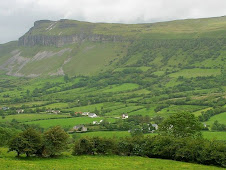Iarnród Éireann, Ireland's state-owned national railway company, has announced that an official investigation into the collapse of a part of the main Dublin to Belfast railway line near Malahide in Co. Dublin (see yesterday's entry) is going to take place.
Well, this is the least one could and should expect after such a disastrous and embarrassing incident.
In fact, this investigation should not be held just by Iarnród Éireann's own staff, but augmented by Gardai and specialists from the Health & Safety Executive.
After all, lives could easily have been lost and much further damage could have been done had the collapsed segment of the viaduct across the Broadmeadow estuary not been spotted and reported by a train driver.
As operator of the line, Iarnród Éireann has a vested interest in the matter, as well as the full and sole responsibility for the maintenance of track, structures, engines and rolling stock.
So a public investigation, or one with participation of experts from outside the railway company, would make a big difference and could prevent an internal cover-up.
A spokesperson for Iarnród Éireann said that "the collapsed section of the railway bridge has undergone a structural examination" only a few days ago. This inspection was "carried out on the line by an engineer on Tuesday, and no issues were identified".
According to Iarnród Éireann all its railway lines are "inspected three times a week by a patrol man, and given a structural assessment by an engineer every two years".
These statements are not satisfactory at all and raise a number of further questions:
- Was the inspecting engineer qualified for his job?
- Did he do his job well? And if he did, why did the railway bridge collapse three days later?
- Was it the regular two-year structural assessment?
- Or was it a special inspection because a patrol man had noticed something unusual? If so, what was it?
- Did Iarnród Éireann's management know that there was something wrong with this part of the line? Or that it was in a bad state of maintenance?
- What exactly did the engineer find and report on Tuesday?
- Did he spot a problem, but was overruled or ignored by his superiors in the company?
 Concrete is a solid substance and does not crumble easily. There is, however, even for concrete an element of wear and tear (like for everything), and it can be particularly prone to deterioration or erosion when it is in close proximity to water. In the case of the collapsed segment of railway line this is certainly the case.
Concrete is a solid substance and does not crumble easily. There is, however, even for concrete an element of wear and tear (like for everything), and it can be particularly prone to deterioration or erosion when it is in close proximity to water. In the case of the collapsed segment of railway line this is certainly the case.It is very hard to believe that the structure was in perfect order when inspected on Tuesday, and then collapsed completely on Friday, only three days later.
Iarnród Éireann states that it will take at least three months before the damage is repaired.
In the meantime trains will only operate between Drogheda and Skerries, and Iarnród Éireann has advised customers travelling between Dublin city and all stations north of Malahide to use Dublin Bus or Bus Éireann services.
Belfast Enterprise services will operate trains between Belfast and Drogheda, and organise bus transfers between Drogheda and Connolly station in Dublin.
But DART (Dublin area railway) services between Malahide and Howth Junction are operating normally.
Up to 10,000 passengers per day are facing disruption and inconvenience for at least three months. Commuters who normally use the Belfast to Dublin trains have been told to add around 30 minutes to their usual journey time.
The passengers' lobby organisation Rail Users Ireland has said it is "extremely concerned" following the collapse, which "raises serious questions of Irish Rail's maintenance and inspection regime".
It also called for cash refunds for all holders of weekly, monthly and annual tickets that are now unable to travel.
Although I am not a member of Rail Users Ireland, I wholeheartedly agree with their statement and demands. The overall state of Ireland's railway system is pretty bad for a long time. It is a run-down service, unloved by the government, which would like to privatise it, if it could find someone mad enough to buy it.
For a long time both the government and Iarnród Éireann completely overlook the great potential rail travel could have here, if it was done the right way. Not even to mention how much more we could do for the environment if major transports of large-size items and goods in bulk would be shifted from Ireland's narrow roads to the railways.
A hundred years ago Ireland had one of the most impressive and effective railway systems in Europe, and even fifty years ago there was still plenty of it around. But due to deliberate State vandalism and extreme ignorance during the 1950s and 1960s the once splendid network was savaged and ripped to pieces. What we are left with is a broken skeleton structure of what we had when railways were en vogue. But instead of improving the situation and making Ireland's railways fit for the 21st century, the people in charge close their eyes, don't want to know about the various problems inside the system, and some are even permanently asleep on the job.
To begin with, we need a Minister for Transport who likes and understands railways. As long as Noel Dempsey, the government's bouncer from Co. Meath, is in charge, things can - and will - only go from bad to worse.
The Emerald Islander








































No comments:
Post a Comment